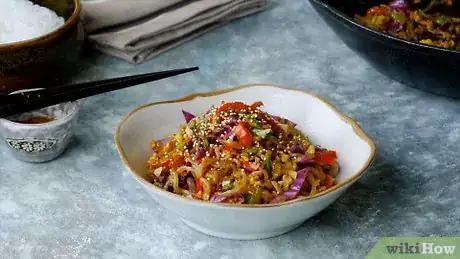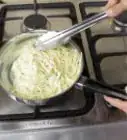This article was co-authored by Ririka Evans. Ririka Evans is a Personal Chef and the Founder of Home Cooking Solutions based in Frederick, Maryland. She has been a Chef for over 11 years at commercial kitchens across Japan and the US. She specializes in Japanese food and home-cooked meals. She creates customized menus and cooks for both families and special events. She’s prepared meals for clients from all walks of life, including public figures, CEOs, business owners, professionals, and busy families. She studied cooking and catering at Stratford Career Institute and is a certified ServSafe Food Protection Manager.
wikiHow marks an article as reader-approved once it receives enough positive feedback. In this case, several readers have written to tell us that this article was helpful to them, earning it our reader-approved status.
This article has been viewed 88,063 times.
Shirataki noodles are a zero calorie food that can be used in any tasty dish. Alone, Shirataki noodles don't have much of a flavor, but they readily absorb whatever flavors you add to them. Let's get cooking!
Steps
Boiling the Noodles
-
1Open the packaging. Remove some packages by pulling the plastic away at any spot that is labeled “pull here”. Open packages without this feature by simply cutting them with a good pair of scissors.
- Keep in mind many Shirataki packages will have liquid in them.
- Don't worry about any smell the noodles might have.
-
2Rinse the Shirataki noodles. Rinsing noodles for 2-3 minutes will remove any residue from the manufacturing process.[1]
- Use cold water when rinsing.
- Use a strainer for best results.
- Rinse the noodles thoroughly.
Advertisement -
3Prepare water for boiling. Place a pot of water on your stove top. Turn the burner on underneath it to start raising the temperature of the water.
- Keep watch over the water to prevent it from boiling over.
- Turn the heat down if the water is boiling too strongly.
-
4Add noodles to boiling water. Boil the noodles for 2 or 3 minutes. Try to get the noodles soft or otherwise at your preferred level of firmness.
- Boiling noodles too long will result in rubbery noodles.
- Don't boil too long as the water will evaporate, resulting in burnt noodles.
-
5Strain the water from the noodles. Grab a strainer and put it in your sink. Pick up the pot with the water and noodles. Bring the pot over to the strainer and slowly pour the water and noodles into the strainer. Dump the noodles out of the strainer and back into your pot.
- Pour the water and noodles out slowly into the strainer.
- Be careful! Your water will be hot and can cause burns and injury.
Roasting the Noodles
-
1Heat up a pan. Put a pan on your stove top and bring up the temperature of it. Add some cooking oil at this stage.
- Heat until the oil sizzles.
- Use a cast iron pan for best results.[2]
-
2Add the noodles to the hot pan. Dry roast them for about 1 minute. Stir them occasionally to prevent them from sticking to your pan and to roast them evenly.
- Thicker noodles will take longer to cook.
- Thin noodles will cook quickly. Take care not to overcook them.
-
3Remove noodles when dry. Roast the noodles until they are dried. Stir them and listen for a squeaking noise. Take them away from heat when they make this noise or are cooked to your preference.
- Dry roasting will help remove any rubbery texture the Shirataki noodles might have.
Serving the Noodles
-
1Add the noodles to another dish. Use the noodles as an ingredient for another recipe you have prepared. Mixing the noodles into another recipe can be a great way to enhance a meal you already enjoy.
- Shirataki noodles don't have a flavor of their own, so they won't affect the taste of your dish.
- Increase the serving size of your dish without increasing the calories.
-
2Add other ingredients to your noodles. Turn your noodles into the main course by adding any flavor or ingredients you enjoy. Mix in these other ingredients to impart their flavor into your Shirataki noodles.
- Use any flavors or ingredients you like.
- Shirataki noodles are great at absorbing whatever flavors they mix with.
-
3Enjoy! Have fun experimenting with new recipes, adding Shirataki noodles to new dishes, or using new flavors.
Community Q&A
-
QuestionMine come out rubbery. What am I doing wrong?
 Community AnswerDid you try rinsing them in water and using a sauce for the last few minutes of warming? That should help if you find them rubbery, but keep in mind that shirataki is slightly rubbery in general.
Community AnswerDid you try rinsing them in water and using a sauce for the last few minutes of warming? That should help if you find them rubbery, but keep in mind that shirataki is slightly rubbery in general. -
QuestionThe article said to cook them dry, but right before that it said to add oil to the pan. Which is it?
 Community AnswerTypically it depends on what packaging they were in. If they already had liquid, rinse them, then use the oil method. Also use the oil if they came with no liquid.
Community AnswerTypically it depends on what packaging they were in. If they already had liquid, rinse them, then use the oil method. Also use the oil if they came with no liquid.
Warnings
- Do not forget to rinse them.⧼thumbs_response⧽
- Do not overcook them as they become rubbery.⧼thumbs_response⧽
- Never leave your stove unattended when cooking.⧼thumbs_response⧽
References
About This Article
To cook shirataki noodles, start by rinsing the noodles in a strainer and bringing a pot of water to a boil. Then, place them in the boiling water and cook them for 2-3 minutes. Next, strain your noodles to get rid of the water, and combine them with a sauce to make the noodles the main course. Alternatively, add them to any of your favorite dishes, since shirataki noodles don't have a flavor of their own. For tips on how to roast shirataki noodles, keep reading!



















































